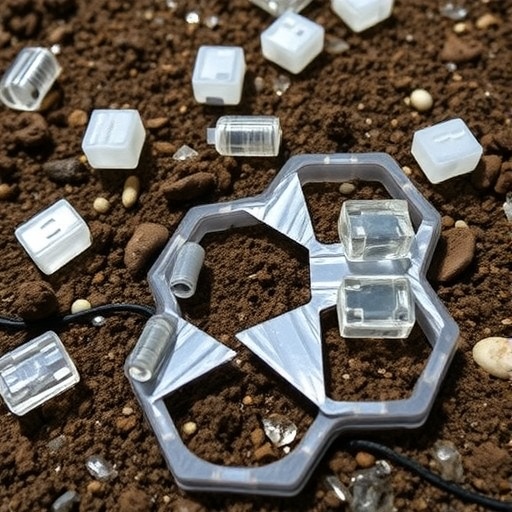Recent advancements in environmental science have unveiled critical insights into the interactions between traditional microplastics and heavy metal contamination in coastal saline soils. The research conducted by Shang et al. provides a comprehensive understanding of how microplastics not only alter the microbial community dynamics but also impact metabolite production and overall nutritional parameters in these contaminated ecosystems. As the urgency surrounding plastic pollution intensifies, this study emphasizes the need for a deeper investigation of microplastic effects on soil health, particularly in regions affected by heavy metal pollution.
The study underscores the alarming presence of microplastics in various environments, particularly in coastal areas where they intermingle with heavy metal contaminants. Microplastics, which originate from the breakdown of larger plastic debris as well as from the release of microbeads and industrial products, have become pervasive in ecosystems. Their ability to adsorb harmful contaminants, including heavy metals, raises serious questions about their ecological role and the long-term impacts on soil health and microbial communities.
In the framework of this research, the authors conducted a series of experiments to analyze the microbial community structures in soil saturated with heavy metals and exposed to traditional microplastics. The findings revealed significant shifts in microbial populations, suggesting that microplastics serve as new ecological niches for microbial colonization. These shifts can lead to a cascade of effects, including alterations in nutrient cycling, soil structure, and biogeochemical processes.
Metabolomic analyses further highlighted the implications of these microbial community changes. By identifying variations in metabolite profiles, the researchers demonstrated how the presence of microplastics influenced the metabolic pathways of soil microbes. Certain beneficial metabolites crucial for plant growth and soil fertility were diminished, signaling potential risks to agricultural productivity and ecosystem service sustainability.
Interestingly, the research provided evidence of positive and negative correlations among different microbial groups in response to microplastics and heavy metal exposure. Some microbial taxa exhibited resilience, fostering an adaptive capacity to the stressful environment. However, this resilience came at a cost; the overall biodiversity of the microbial community suffered, which is alarming as diverse ecosystems are often more stable and resilient to environmental changes.
Additionally, the study noted impacts on nutritional aspects related to organic matter decomposition and nutrient availability. Heavy metal contamination is already known to hinder microbial activity; when combined with microplastics, the situation exacerbates the challenge of restoring soil health and productivity. The authors emphasized the interconnected nature of pollution, highlighting that an integrated approach toward pollution management is imperative to mitigate compounded effects.
Land management practices must evolve in light of these findings. The paradox of plastic pollution necessitates a reconsideration of agricultural practices, particularly in coastal regions. Farmers and policymakers could benefit from acknowledging how plastic remnants in the soil influence microbial health and soil nutrient dynamics. Sustainable practices, organic amendments, and remediation strategies such as phytoremediation may need reevaluation to ensure that they are not unintentionally exacerbating the problem.
Despite the significant findings, the research highlights the complexity of interactions involved in soil ecosystems. The interplay between microplastics and heavy metals is intricate, and future studies will be crucial in unraveling these relationships. Understanding the underlying mechanisms will aid in developing strategies to combat the adverse effects of pollution on soil health, thereby improving agricultural sustainability and ecosystem resilience.
Furthermore, the implications of this research extend beyond soil health, as it poses potential risks to food chains and human health. With microplastics infiltrating agricultural soils, there is a looming question about their entry into the food supply. The study raises awareness about the thorough examination of food safety protocols, particularly in regions where heavy metal contamination and microplastic exposure are prevalent.
The urgency of addressing microplastic pollution cannot be overstated. As the global population continues to rise, the pressure on natural resources increases, necessitating immediate action to mitigate the sources of plastic waste. Increased public awareness and community engagement in sustainability efforts could play a pivotal role in combating this growing crisis.
In conclusion, Shang et al.’s study elucidates the profound implications of traditional microplastics on microbial communities and nutrient cycles within heavy metal-contaminated coastal saline soils. As the research space evolves, ongoing investigations focusing on the interactions between various types of pollutants and ecosystem components will be vital. This comprehensive exploration into microplastic impacts signals an essential step towards healthier ecosystems and sustainable agricultural practices that acknowledge the complexity of environmental interconnections.
Subject of Research: The impact of traditional microplastics on microbial community structures, metabolites, and nutrition in heavy metal-contaminated coastal saline soil.
Article Title: Traditional microplastics alter microbial community, metabolites and nutrition in heavy metal-contaminated coastal saline soil.
Article References:
Shang, Xc., Zhao, Lp., Xiong, Y. et al. Traditional microplastics alter microbial community, metabolites and nutrition in heavy metal-contaminated coastal saline soil.
Commun Earth Environ 6, 867 (2025). https://doi.org/10.1038/s43247-025-02770-8
Image Credits: AI Generated
DOI: https://doi.org/10.1038/s43247-025-02770-8
Keywords: Microplastics, heavy metals, microbial communities, soil health, coastal ecosystems, metabolites, agriculture, pollution, sustainability.




